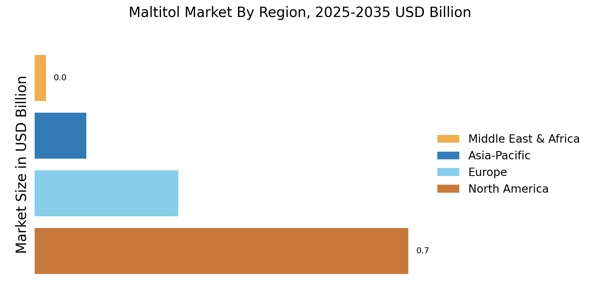Innovation in Food Technology
The Maltitol Market is significantly influenced by advancements in food technology. Innovations in processing and formulation techniques have enabled manufacturers to enhance the functionality of maltitol in various applications. For example, the development of new blending methods allows for improved taste profiles and texture in products containing maltitol. Additionally, the rise of plant-based and organic food trends has led to increased interest in natural sweeteners, including maltitol derived from corn. This innovation not only caters to consumer preferences but also positions maltitol as a versatile ingredient in the food industry. The market for maltitol is expected to grow as food technologists continue to explore its potential in creating healthier, more appealing products.
Health Conscious Consumer Trends
The Maltitol Market is experiencing a notable shift driven by the increasing health consciousness among consumers. As individuals become more aware of the adverse effects of excessive sugar consumption, there is a growing preference for sugar substitutes. Maltitol Market, being a low-calorie sweetener, appeals to those seeking to reduce caloric intake without sacrificing sweetness. According to recent data, the demand for sugar alternatives is projected to grow at a compound annual growth rate of approximately 5.5% over the next few years. This trend is particularly evident in the confectionery and bakery sectors, where manufacturers are reformulating products to include maltitol as a healthier option. The rising prevalence of obesity and diabetes further propels this trend, as consumers actively seek products that align with their health goals.
Rising Popularity of Low-Carb Diets
The Maltitol Market is witnessing a surge in demand due to the rising popularity of low-carbohydrate diets. As more consumers adopt ketogenic and other low-carb lifestyles, the need for suitable sweeteners that align with these dietary choices becomes paramount. Maltitol Market, with its low glycemic index, serves as an ideal alternative for those looking to satisfy their sweet cravings without the associated carbohydrate load. Market analysis indicates that the low-carb food segment is expected to grow significantly, with maltitol playing a crucial role in product formulations. This trend is particularly pronounced in the snack and dessert categories, where consumers are actively seeking options that support their dietary preferences while still delivering on taste.
Regulatory Support for Sugar Substitutes
The Maltitol Market benefits from favorable regulatory frameworks that encourage the use of sugar substitutes. Various health organizations and government bodies have recognized the potential of maltitol in promoting healthier dietary choices. For instance, regulatory approvals for maltitol as a safe food additive have facilitated its incorporation into a wide range of products. This regulatory support not only enhances consumer confidence but also incentivizes manufacturers to innovate and expand their product lines. The market for sugar substitutes, including maltitol, is projected to reach USD 1.5 billion by 2026, indicating a robust growth trajectory. As regulations continue to evolve, the Maltitol Market is likely to see increased investment and research aimed at developing new applications and formulations.
Expansion of E-commerce and Online Retail
The Maltitol Market is experiencing a transformative shift with the expansion of e-commerce and online retail platforms. As consumers increasingly turn to online shopping for convenience, the availability of maltitol-containing products has surged. This shift not only broadens the market reach for manufacturers but also allows consumers to access a wider variety of products that incorporate maltitol as a sweetener. Data suggests that online sales of food products, including sugar substitutes, are projected to grow at a rate of 10% annually. This trend is likely to enhance brand visibility and consumer engagement, ultimately driving growth in the Maltitol Market. As e-commerce continues to evolve, it presents new opportunities for innovation and marketing strategies tailored to the digital consumer.


















Leave a Comment